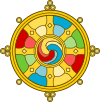11th Dalai Lama
Khedrup Gyatso (1 November 1838 – 31 January 1856) was the 11th Dalai Lama of Tibet.[1]
Khedrup | |||||||||
|---|---|---|---|---|---|---|---|---|---|
| Title | 11th Dalai Lama | ||||||||
| Personal | |||||||||
| Born | 1 November 1838 | ||||||||
| Died | 31 January 1856 (aged 17) | ||||||||
| Religion | Tibetan Buddhism | ||||||||
| Senior posting | |||||||||
| Period in office | 1842–1856 | ||||||||
| Predecessor | Tsultrim Gyatso | ||||||||
| Successor | Trinley Gyatso | ||||||||
| Chinese name | |||||||||
| Chinese | 凱珠嘉措 | ||||||||
| |||||||||
| Tibetan name | |||||||||
| Tibetan | མཁས་གྲུབ་རྒྱ་མཚོ་ | ||||||||
| |||||||||
| Part of a series on |
| Tibetan Buddhism |
|---|
 |
|
|
|
Practices and attainment |
|
Institutional roles |
|
History and overview |
He was recognised as the Eleventh Dalai Lama in 1840, having come from the same village as Kelzang Gyatso, the seventh Dalai Lama, had in 1708. In 1841, Palden Tenpai Nyima, 7th Panchen Lama, gave him the pre-novice ordination, cut his hair and gave him the name Khedrup Gyatso.[1]
In 1842, he was enthroned in the Potala Palace and, in 1849, at the age of eleven, he took the novice vows of monkhood from Palden Tenpai Nyima, 7th Panchen Lama[2]
He was enthroned on 25 May 1842 and assumed full power on the request of his government on 1 March 1855. However, he died less than one year later, thus becoming the third successive Dalai Lama who died at too young an age to consolidate his power.
- "During the period of the short-lived Dalai Lamas—from the Ninth to the Twelfth incarnations—the Panchen was the lama of the hour, filling the void left by the four Dalai Lamas who died in their youth."[3]
He wrote a book of stanzas, Story of the Monkeys and Birds (Bya sprel gyi gtam-rgyud). It is an allegory of the war at the end of the 18th century between the Tibetans and the Gurkhas ('birds' and 'monkeys' respectively).[4]
During the life of Khedrup Gyatso, wars over Ladakh weakened the lamas' power over the Tibetan Plateau and the First and Second Opium Wars as well as the Taiping Rebellion simultaneously weakened Chinese influence on Tibet. In the last years of his reign the Nepalese invaded Tibet, but were defeated in the Nepalese-Tibetan War (1855–1856).
He died suddenly in the Potala Palace, Lhasa, Tibet, Qing Dynasty on 31 January 1856.
References
- "His Holiness the Eleventh Dalai Lama, Khedrup Gyatso". The Office of His Holiness The Dalai Lama. Archived from the original on 30 August 2012. Retrieved 16 July 2012.
- Khetsun Sangpo Rinpoche. (1982). "Life and times of the Eighth to Twelfth Dalai Lamas." The Tibet Journal. Vol. VII Nos. 1 & 2. Spring/Summer 1982, p. 50.
- The Fourteen Dalai Lamas: A Sacred Legacy of Reincarnation, p. 175. Glenn H. Mullin. Clear Light Publishers. Santa Fe, New Mexico. ISBN 1-57416-092-3.
- Stein, R. A. (1972) Tibetan Civilization, p. 269. Stanford University Press. ISBN 0-8047-0806-1 (cloth); ISBN 0-8047-0901-7 (pbk)
Further reading
- Mullin, Glenn H. (2001). The Fourteen Dalai Lamas: A Sacred Legacy of Reincarnation, pp. 361–367. Clear Light Publishers. Santa Fe, New Mexico. ISBN 1-57416-092-3.
| Buddhist titles | ||
|---|---|---|
| Preceded by Tsultrim Gyatso |
Dalai Lama 1842–1856 Recognized in 1841 |
Succeeded by Trinley Gyatso |